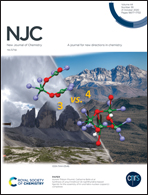Design of a redox-active “water-in-salt” hydrogel polymer electrolyte for superior-performance quasi-solid-state supercapacitors†
Abstract
The enhancement in specific energy (SE) of supercapacitors (SCs) by increasing the operating voltage and/or specific capacitance is the focus of this study, particularly for the quasi-solid-state supercapacitors. Herein, a redox-active “water-in-salt” (WIS) hydrogel polymer electrolyte (HPE) possessing a wide operating voltage and exhibiting pseudocapacitance was synthesized by the stepwise dissolution of polyvinyl alcohol (PVA) and redox additive KBr in a 5 m (mol kgwater−1) lithium bis(trifluoromethylsulphonyl)imide (LiTFSI) WIS solution. The dependence of the ionic conductivity of PVA–LiTFSI–KBr HPE on the KBr mass was investigated and the optimized PVA–LiTFSI–KBr HPE with a maximum ionic conductivity of 43.3 mS cm−1 was acquired. The optimized PVA–LiTFSI–KBr HPE was covered by two identical activated carbon (AC) electrodes to form a sandwich-configuration SC. This device can deliver a large SE of 34.5 W h kg−1, mainly attributed to the observation that the as-prepared HPE inherits the character of the WIS electrolyte, in which the reduced water activity leads to suppressed water decomposition, resulting in the wide operating voltage of 2.0 V. The Br−/Br3− redox reaction at the HPE/AC electrode interface exhibits additional pseudocapacitance. In addition, a remarkable cyclic stability and excellent self-discharge performance are demonstrated in this device.



 Please wait while we load your content...
Please wait while we load your content...